All you need to know about B2B reporting (+templates and examples)

Suppose you’ve wondered how to connect B2B marketing activities to return on investment (ROI) and best communicate these updates to your clients or executive team in real time. In that case, today’s article is for you.
Done well, business-to-business (B2B) reporting helps you optimize your marketing spending and build a clear proof of the ROI of your marketing activities to your team and stakeholders.
- What is B2B reporting
- - Why B2B companies need to track their progress with reporting
- What metrics should your B2B report include?
- A report template for B2B marketing your clients or executives will love
- 3 B2B SaaS reporting tools to simplify your reporting process
- Create stunning B2B reports with DashThis
What is B2B reporting?
B2B reporting analyzes all sales, marketing, and financial metrics of a business selling products and services to other businesses instead of directly to consumers.
With accurate reporting, you’ll
- turn your data from multiple sources into actionable recommendations
- know which marketing activities and channels to focus on
- how to communicate updates to your team, executive or client.
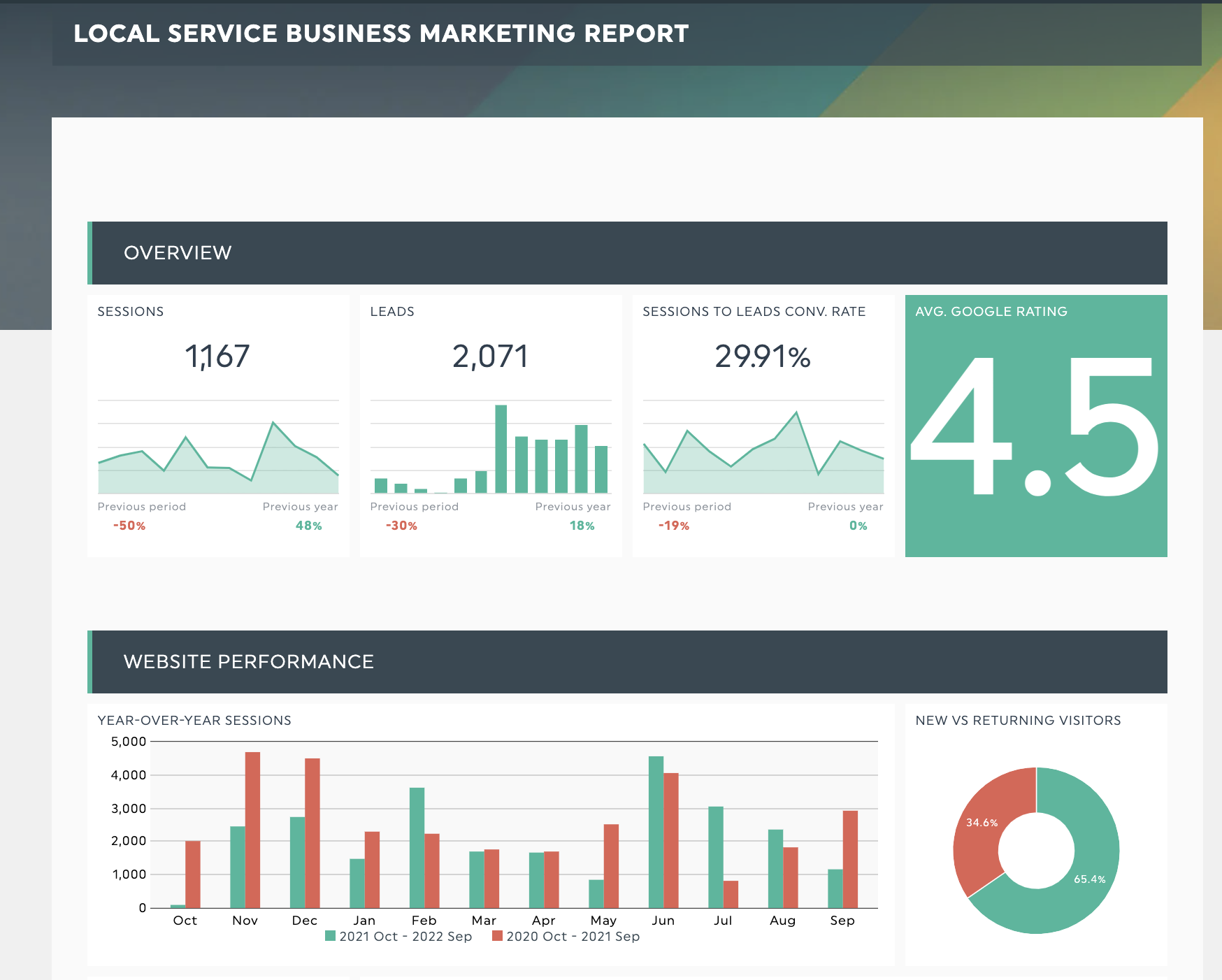
Get this local business marketing report with your own data!
Why B2B companies need to track their progress with reporting
Whether you create blog content, invest in social media, or run paid advertising campaigns, there are many marketing activities your organization can do.
But if you don't know which activities generate ROI, you can generate a lot of traffic that doesn’t help you meet your KPIs.
Here’s our take: doing marketing without a regular reporting schedule and format is like flying an airplane blind.
If you’ve felt this way, you’re not alone.
30% of marketers in HubSpot’s internal research said measuring the ROI of marketing activities was a priority in 2022. Separately, only 10% of 176 B2B marketing executives said their company had an excellent ability to measure and analyze marketing performance and impact in a study by Demand Gen Report.
Done well, reporting helps align your teams around a standard measure of progress and helps you instill trust in your clients and internal stakeholders.
Reporting ties marketing activity to results, helping teams align internally.
Which marketing activities move the needle, and which do not?
Without a report to measure progress, it’s tough to answer these questions. The issue compounds when you’re responsible for a marketing team.
Regular reporting helps you track what everyone on your team is doing, where they’re facing challenges, and whether you’re using your marketing resources correctly.
Let’s say you’re managing a multi-channel digital marketing campaign. With a report to track your progress, you’ll get early feedback if people are opening and engaging with your emails, making it easier to make adjustments.
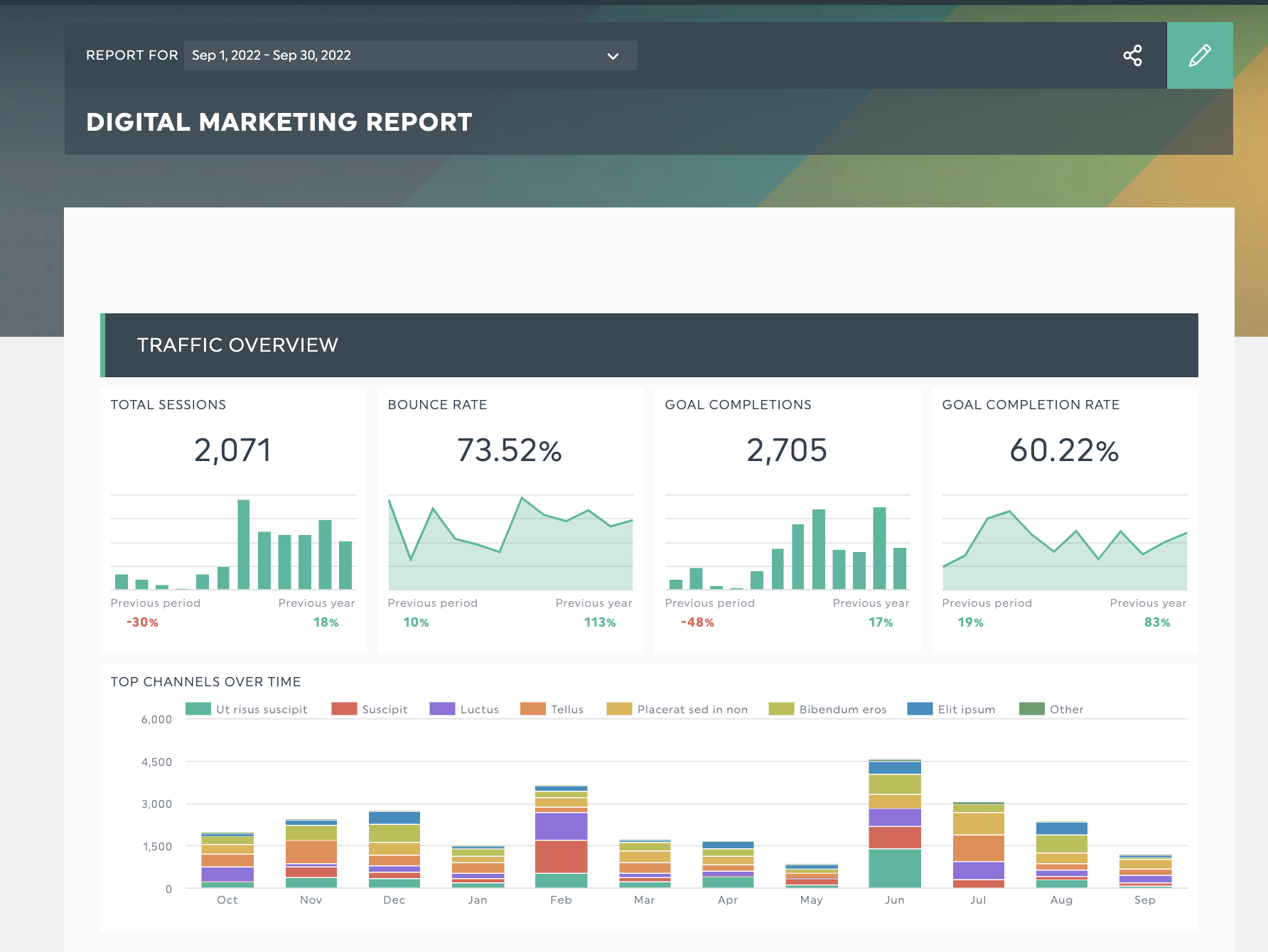
Get this digital marketing report with your data!
Reporting creates a feedback loop on what’s working and not, making decision-making simpler.
Getting a new marketing strategy or brand awareness campaign approved by your client or executive?
Getting clear on your ROI and identifying the metrics that align with internal and business stakeholders' goals helps you make your case easier.
For example, suppose you need to justify investing in marketing to your head of commercial or sales who cares about revenue generation. In that case, you’ll want to show how your marketing campaign will generate more MQLs and SQLs, increase customer lifetime value, and sales revenue.
Sometimes improving marketing effectiveness isn’t about increasing budgets but the optimization of existing programs.
Chris Walker from marketing agency Refine Labs, describes why increasing the marketing budget isn’t always the answer to improve marketing performance.
Tons of marketing teams come to me and say, “We need more budget”. But here’s the truth: You don’t need more budget. You need to make your existing budget drive significantly better ROI. And the way you make your existing budget drive significantly better ROI is by scrutinizing all of your marketing budget & programs and making choices about what not to do.
To do that, you need actionable feedback - feedback regular reporting provides.
What metrics should your B2B report include?
Metrics here focus on communicating the efficiency of sales and marketing initiatives and how these tie to B2B business revenue.
Customer acquisition cost (CAC)

Customer acquisition cost benchmarks how much you spend to gain a new customer.
CAC includes:
- How much you’re spending on a campaign (costs paid to digital advertising platforms like Google Ads, Facebook Ads)
- Headcount and salaries of your marketing and sales teams and any third-party vendors
- Infrastructure costs (office spaces, equipment, etc)
Looking at CAC in more detail, you’ll know if you spend too much (or too little) on marketing, which channels help you acquire customers at the lowest possible cost, and where to focus your efforts.
Together with customer lifetime value and ROI calculations, which we’ll dive into, these metrics give you a complete picture of the health of your marketing and sales efforts and whether your marketing funnels need attention.
Return on marketing investment (ROI)

Did your marketing campaign generate more sales than it cost to put together?
ROI is all about; assessing results alongside your investment to understand if it’s worth continuing.
You’ll want to analyze this on a few levels.
- Overall marketing ROI. Look at your marketing spend divided by the amount earned in sales to track overall business/marketing health.
- Channel/campaign ROI. Once you know your overall marketing ROI, analyze different channels (e.g., paid ads, email marketing, and content marketing) to see which ones you should focus on.
Are your marketing efforts generating conversions and qualified leads? If not, what can you change to improve the channel’s performance? Or, if it’s underperforming for longer, would it be time to abandon the channel altogether?
Tip: Define your period for ROI calculations, depending on the length of your sales cycle. It could be weeks or years, depending on your product or service. Also, look at the return on ad spend (ROAS) if paid marketing is a big part of your marketing strategy and lead generation efforts.)
Conversion rate

Conversion rate analyses how often someone takes a desired action on your paid ads, forms, or landing pages, like subscribing for a free trial or checking out on an e-commerce website.
It’s one of the more straightforward metrics to look at when analyzing your marketing channel or assets' effectiveness. Review your conversion rate across different campaigns, traffic sources, or campaigns to see which ones to focus more attention on.
Customer lifetime value (CLV)
By telling you how much a client is worth in the long run, CLV is a metric that tells you the hard truth about how you’re doing.
CLV data can be a powerful metric to realign your sales and marketing efforts.
“If you have 100 really good customers, what is their profile? Who are they, and where are they from? What are they doing? What is their lifetime value? How can you find more of these people?” - Justin Wu, Growth.ly
Overall, if getting a customer costs as much (or more) than your customer's lifetime value, revisit your marketing campaign or customer retention strategy.
Website metrics (traffic sources, bounce rate, channels, etc.)

Depending on your reporting objectives, consider including website (or landing page) metrics in your report. There are a lot of metrics out there, so focus on metrics that are meaningful and relate to your objectives.
Let’s put this into practice with an example, our B2B SEO report.
All metrics shown here are laser-focused on telling a story about SEO performance; top landing pages from organic sessions, conversions, devices, and overall channels by sessions, helping you get a complete picture of your SEO performance.

Get this B2B SEO report template with your own data.
Bonus: You can create stunning and detailed reports in 5 minutes! See how it’s done in DashThis here.
A report template for B2B marketing your clients or executives will love
Need to get all your B2B metrics in one place? We’ve got the template for you.
Business executive report template

Get this B2B executive report with your own data.
Senior executives are busy, so they quickly get to the point when presenting data. When thinking about which metrics to include in your report, think about two things:
- Which business goals are a priority right now?
- What does this person care about, and how can I address their concerns?
3 B2B SaaS reporting tools to simplify your reporting process
Mailchimp

Mailchimp transitioned from an email marketing tool to a fully-fledged marketing automation platform, especially for small businesses.
Where Mailchimp excels is in its personalized recommendations based on your campaign data. This combined with their generous free plan makes Mailchimp beginner-friendly. We also feel the funky brand voice helps put a smile on your face - not something we can say with every software product.
HubSpot
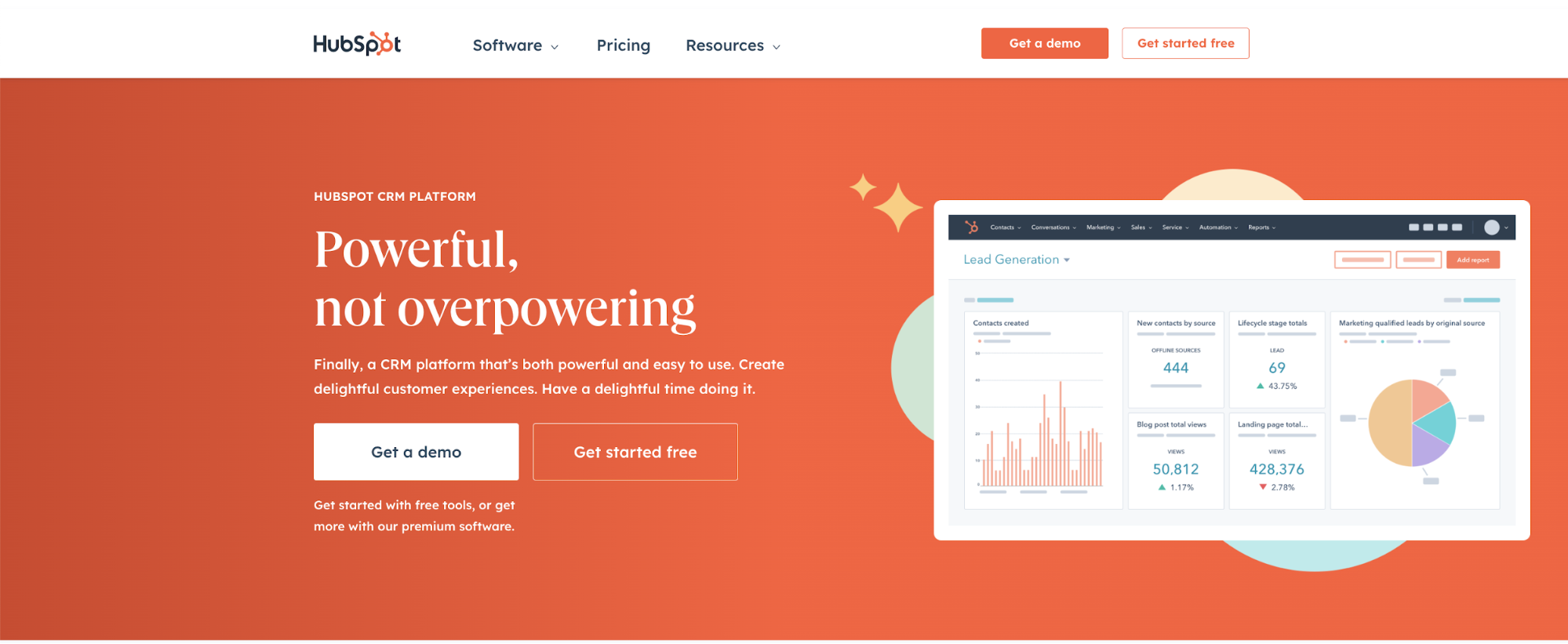
HubSpot is a one-stop hub and CRM tool for all marketing, sales, content management, and customer service. Create custom reports and dashboards by integrating data across your company, making content attribution and decision-making simple.
DashThis
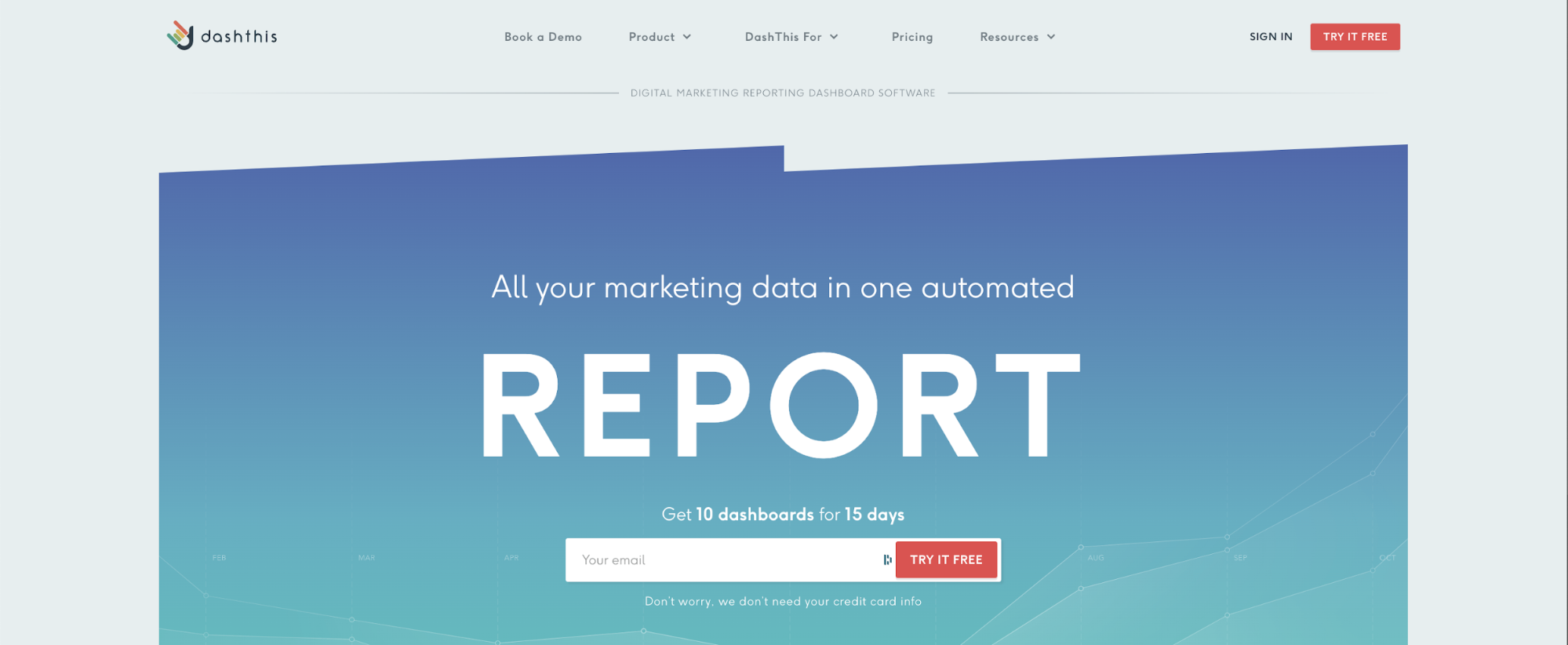
We built DashThis for marketers of all shapes and company sizes, so we know a thing or two about creating educational B2B marketing dashboards in minutes.
With over 40 integrations with B2B marketing and analytics tools like Google Analytics, we’re confident you can get your data into our reports to simplify communication and decision-making.
Create stunning B2B reports with DashThis
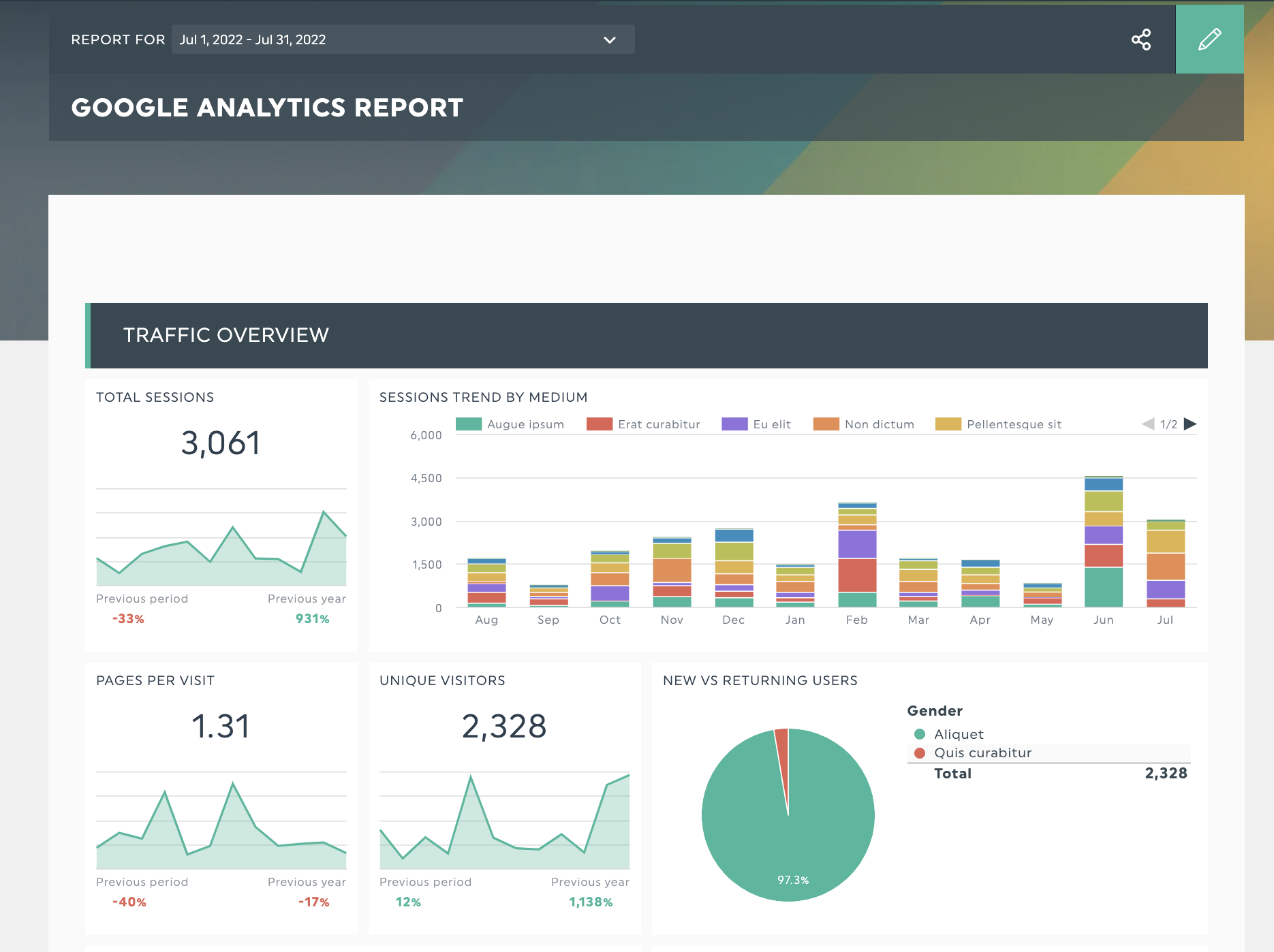
Get 20+ dashboard templates just like this one with DashThis. Try it with your data here.
You can get started in minutes. All you need to do is.
- Sign up for an account with our free 15-day trial
- Connect your marketing tools with our 40+ integrations
- Select the metrics to include from our Preset Widgets
- Choose your preferred preset B2B marketing report template or create a new one from scratch!
Sign up for your free 15-day trial of DashThis today.
Ready to create your B2B report?
Read More
Don’t miss out!
Automate your reports!
Bring all your marketing data into one automated report.
Try dashthis for free

